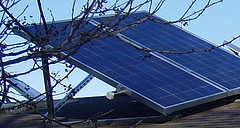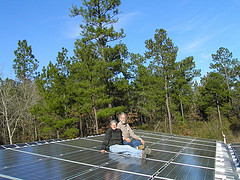 Moore’s Law for solar is about decreasing price per Watt,
or more Watts per dollar.
Here’s an example of a common confusion, to think it’s about efficiency:
Moore’s Law for solar is about decreasing price per Watt,
or more Watts per dollar.
Here’s an example of a common confusion, to think it’s about efficiency:
“The curve will obviously become asymptotic at some point, ie,. the rate of improvement will flatten out, so we end up with a sort of squashed “S” shape curve, because you can’t get more than 100% efficiency — 36 watts/m2 or so.”
And indeed efficiency probably will flatten out soon. But it’s not solar efficiency that’s improving by Moore’s Law: it’s price per watt. That can keep improving for a long time.
Here’s an example of decreasing price. Scott Detrow wrote for NPR 23 December 2012, Forget Fracking: 2012 Was A Powerful Year For Renewables,
“Just to give you perspective,” Resh said, “in Washington, D.C., where I live, when I installed solar on my house six years ago, the average install cost was about $14 a watt. Today it’s about $4 a watt.”
Here’s another comparison, this one just for solar panels.
 In 2005 the first set of solar panels we got cost $670 each
and produced 170 Watts DC each, or $4.94/Watt.
In 2011 our second set of solar panels cost $562 each
for 235 Watts DC each, or $2.39/Watt.
That’s more than 50% price decrease for solar panels in six years.
(I can’t compare inverters or support structures directly,
because those were sized so differently, but those have also
come down in price, helping lower the overall install cost).
In 2005 the first set of solar panels we got cost $670 each
and produced 170 Watts DC each, or $4.94/Watt.
In 2011 our second set of solar panels cost $562 each
for 235 Watts DC each, or $2.39/Watt.
That’s more than 50% price decrease for solar panels in six years.
(I can’t compare inverters or support structures directly,
because those were sized so differently, but those have also
come down in price, helping lower the overall install cost).
| Year | price /Watt | price /panel | Watts /panel | Dimens. | square inches | Watts /100 sq in. | Model |
|---|---|---|---|---|---|---|---|
| 2005 | $4.94 | $670 | 170W | 50×39″ | 1950 | 8.7 | KC 170 |
| 2011 | $2.39 | $562 | 235W | 39.1×64.6″ | 2525 | 9.3 | Sharp ND 235 QCJ |
| 2012 | $1.32 | $310 | 235W | 39.1×64.6″ | 2525 | 9.3 | Sharp ND 235 QCJ |
Meanwhile, the Watts per surface area hardly changed, from about
 8.7 Watts per 100 square inches to about 9.3,
which is only about 7% different, so little it could be due
to framing rather than the usable solar PV area.
The 2011 panels produce more Watts simply because they’re
bigger.
Both models of panels (2005 and 2011) are around 15% efficiency,
according to their specs.
So it’s not efficiency that’s improved in commercial solar
panels from 2005 to 2011: it’s price per watt.
8.7 Watts per 100 square inches to about 9.3,
which is only about 7% different, so little it could be due
to framing rather than the usable solar PV area.
The 2011 panels produce more Watts simply because they’re
bigger.
Both models of panels (2005 and 2011) are around 15% efficiency,
according to their specs.
So it’s not efficiency that’s improved in commercial solar
panels from 2005 to 2011: it’s price per watt.
And those same 2011 Sharp ND 235 QCJ panels now cost $310 each at the end of 2012, for $1.32/Watt, or another 45% price decrease in one year. The 2005 and 2011 prices may have had some installation costs included, but whichever way you look at it, solar PV price per Watt has come way down.
That’s why the NPR story starts like this:
Natural gas may have reshaped the domestic energy market in 2012, lowering energy prices and marginalizing the coal industry, but America’s shale boom hasn’t undermined renewables.
In fact, while analysts were paying attention to fracking this year, a record number of solar panels were being slapped on roofs — enough to produce 3.2 gigawatts of electricity.
And there’s a lot of room for expansion:
That sounds like a lot, but solar is still providing just .05 percent of the country’s total energy.
Which is a big reason we’ll see Moore’s Law for solar continue for a long time yet: we’ve hardly even reached mass market at this point, and as we do, economy of scale will keep pushing prices down.
The bulk of solar growth is happening at businesses; companies are installing panels on roofs so that they don’t have to buy as much energy from the grid. State and federal policies are making that an easy decision for companies. Businesses who install panels can qualify for grants and tax breaks, and laws in 38 states require a certain amount of electricity to be generated by solar, wind and other renewable sources.
Businesses can often get financing for solar; private individuals (and small businesses) often can’t, at least not in Georgia, with that 1973 Territorial Electric Service Act in the way. Imagine the solar boom in Georgia, with jobs and reduced electric bills for south Georgia, if the legislature changes that law!
More on what underlies Moore’s Law for solar in a later post.
-jsq
Short Link: